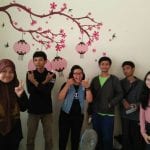Have you ever heard wagashi? If you did, you’re surely into Japanese things! What are wagashi? Wagashi are traditional Japanese sweets that have been eaten in Japan for generations. Japan has many varieties of wagashi. Some of them are eaten seasonally, or on special occasions, and all the regions of Japan have specialty wagashi products. Wagashi are highly artistic, with designs which express the beauty of nature and the seasons.
Wagashi are typically enjoyed in combination with a cup of green tea. They are made in a wide variety of shapes and consistencies and with diverse ingredients and preparation methods. Some are popular across the country and around the year while others are only available regionally or seasonally. It also differ from one region to other region in Japan.
So, what are wagashi made of? Sweet azuki bean paste (anko) is a central ingredient in a large number of Japanese sweets. Boiled azuki beans are sweetened with sugar and mashed to create either smooth anko (koshian) or chunky anko (tsubuan). Other common ingredients for wagashi include rice cakes (mochi), rice flour, Japanese agar (kanten), sesame paste and chestnuts.
Wagashi is sometimes called an art of collaboration among the five senses. In evoking the seasons and landscape of Japan, the shapes, colors, and designs of wagashi appeal to the sense of sight. The rich flavors of natural ingredients appeal to the sense of taste. The textures we experience when we take the confections by hand, cut them for serving, or place them in our mouth, appeal to the sense of touch. The delicate aromas appeal to the sense of smell. Even the sense of hearing is stimulated by the sound of the lyrical names, with their literary or seasonal associations.
Here some famous wagashi, and I bet you have heard some of it on manga or anime.
1. Namagashi (生菓子)
Namagashi (lit. raw sweets) are traditional Japanese sweets that are most often associated with wagashi. They are made of rice flour and a sweet bean paste filling, and are delicately shaped by hand to reflect the season. Namagashi are served at the tea ceremony.
- Daifuku (大福)
Daifuku are made of soft rice cake (mochi) wrapped around a small round of smooth, sweet bean paste or other fillings. They are covered with a light dusting of potato starch to keep them from sticking together. Popular daifuku variations include strawberry (ichigo), beans (mame) and ice cream. Daifuku should be eaten quickly as they become hard if left exposed.
3. Dango (だんご)
Dango are chewy, small, steamed dumplings made of rice flour. They are typically served skewered three or four to a stick and topped with a sweet sauce or bean paste. The dumplings are also added into other desserts like anmitsu and oshiruko. Like daifuku, dango are best eaten fresh.
- Dorayaki (どら焼き)
Dorayaki consist of sweet bean paste sandwiched between two pancake-like patties. It is also known as the favorite snack of Doraemon, a popular animecharacter. Modern dorayaki variations may be filled with other fillings, such as whipped cream, custard cream and green tea flavored cream.
5. Manju (饅頭)
Manju are small buns that are steamed or baked and filled with sweet bean paste or some other sweet filling. They are traditionally round with a smooth outer layer, but baked versions in various shapes are also popular. Examples of the baked versions include momiji-manju from Hiroshima.
BY: Departemen Pengembangan Bahasa







